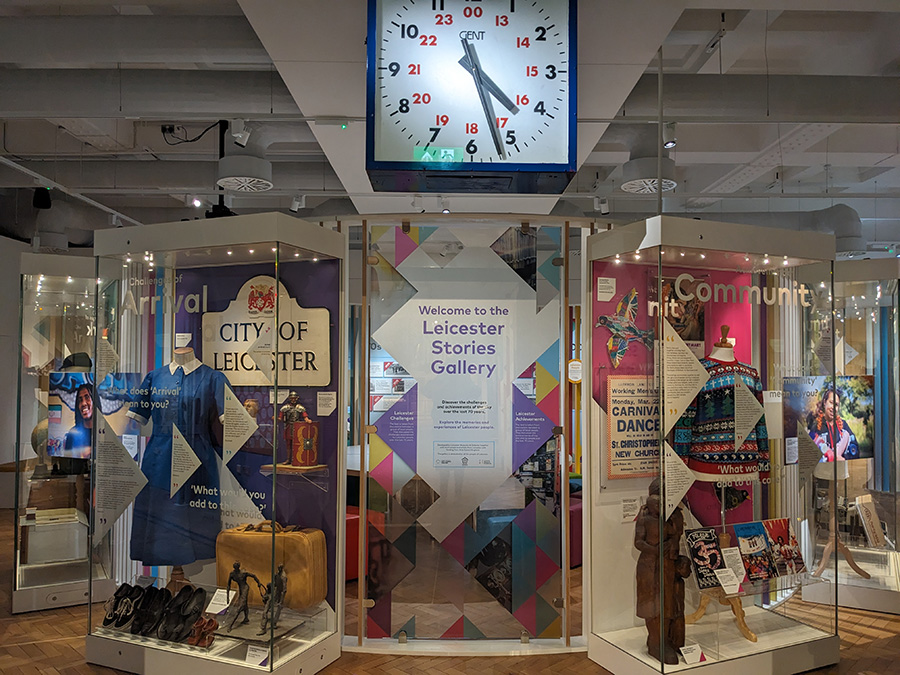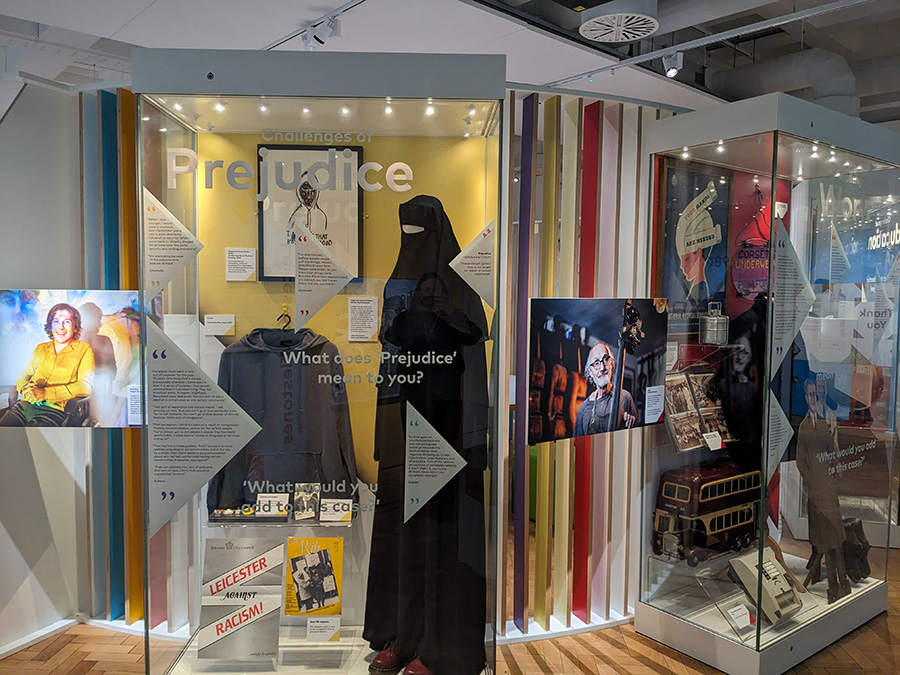The Leicester Stories gallery opened in Leicester Museum and Art Gallery in 2021. It focuses on the stories and voices of people living in Leicester today and features collections from the 1950s onwards as well as temporary displays. In this Q&A, Community Co-Producer Angela Robinson, talks us through the curatorial process behind the gallery.
Angela Robinson, Community Co-Producer
Collection: Leicester Museum & Art Gallery, Leicester
Keywords: Community, Curation, Collaboration, Collections
 Fig.1 Installation view of the Leicester Stories Gallery, showing ‘arrival’ and ‘community’ displays. Photo: S. Hatchwell, 2023.
Fig.1 Installation view of the Leicester Stories Gallery, showing ‘arrival’ and ‘community’ displays. Photo: S. Hatchwell, 2023.
Q:What is the Leicester Stories Gallery about?
Angela Robinson (AR): It's all about Leicester and its people. Leicester is a city of arrival, and we have this idea that if you come to live in Leicester, you're a Leicester person. The aim with the gallery is to capture different people's experiences of the city. It is a celebration of Leicester, but also an honest look at the city and its people over the last seventy years. The gallery is divided into four displays alternating between two themes: challenges and achievements [fig. 1]. Some of the subjects we chose to include were obviously related to the city, like ‘sports’ and ‘industry’. Some of them were less clear-cut: for example, ‘community’, which is a broad yet inclusive concept. We also included ‘education’ as one of our challenges, along with ‘prejudice’ [fig. 2]. Each display includes a selection of different objects and images from the permanent collection that relates to that specific theme, with interpretative text presenting stories and recollections from people in Leicester. These displays are then arranged around a circular workspace in the middle of the gallery. On the outer walls is a timeline of Leicester, which can be updated, and a smaller space where we can display three temporary exhibitions a year. The idea for this rotating exhibition space is to work with local groups within the city to develop displays that highlight the work that those groups are doing.
Q:What makes this gallery different compared to more traditional displays?
AR: We are not object-led, we are people-led, so the choice of objects and the focus of the interpretation is all about people and their stories. In many ways objects take a secondary position – they are there to illustrate the gallery’s themes and stories – while people are the heart of the curation. This is a different approach, and the gallery was very much produced in collaboration with local people.
The first job of the objects in the gallery is to represent the different themes and stories we came up with during our collaborative curation. But at the same time, we know that when people come to museums, they are drawn to objects: they still want to learn about what an object is. This means the objects in the Leicester Stories gallery are doing two things: I'm making them work very hard!
 Fig. 2 Installation view of the ‘prejudice’ display in the Leicester Stories Gallery. Photo: S. Hatchwell, 2023
Fig. 2 Installation view of the ‘prejudice’ display in the Leicester Stories Gallery. Photo: S. Hatchwell, 2023
Q:How did you curate the gallery?
AR: The approach was co-production: as much as possible, working with local people, using people's experiences to inform and develop different elements of the gallery, to decide on the content, and to produce the interpretation.
The curation took 18 months, extended because of Covid. I felt that it was my job as the museum professional to give a certain framework for our co-producers to work within, as the majority of them didn't have any museum background and were giving their time for free. The co-production group worked with me to choose different themes, challenges, and achievements to feature in the gallery. We all had a meeting, I gave them seven possible challenges and seven possible achievements, and they chose which ones we’d use. I thought we'd have three challenges and three achievements, but it was their decision to go for four of each.
Initially, the idea was that we would develop the themes and select the objects through workshops. The co-production group would come to our off-site store, and my colleague and I would have a selection of objects out, to get them thinking about what type of objects relate to the themes. We would then have a discussion that would be recorded and transcribed, which would then become the content for our interpretation. But, in the end, this didn't work because Covid hit, and because of the time-commitment it would need from our co-producers, most of whom had jobs and other sorts of responsibilities to work around.
Instead, we did a tour of our store at the beginning of the project so our co-producers could see the breadth of our collections. Then, we completed all the planning, discussion, and production of interpretation over Zoom. I would chair each session, we’d talk together about the themes, what type of objects we could choose, and the group would give some suggestions. In reality, I chose most of the objects: I couldn't just expect the group to come up with all the content and choose all the objects because they didn't necessarily have the knowledge to do that, and equally that is my role as the museum professional. I’m still trying to figure out how to enable people to really choose objects themselves. With the gallery themes, I gave them suggestions. They chucked some of mine in the bin, they put some new ones in, and at the end we had eight that we decided upon in collaboration.
I had to change my language to make this process more accessible to the co-production group. It was often difficult because we were working with an abstract concept: I hadn't got any drawings or images to demonstrate what the gallery would look like. So they did a lot of it blind, really. But they had confidence in me: I would explain things as best I could, I would answer questions the best I could, and I would be honest when I couldn’t answer.
During this project, I had two roles: I was the collections officer as well as a co-producer. I knew the collections and I could pull out a really good object and get people engaged with it. Having a collections background definitely helped me to achieve the end goal, because even though the gallery is very much people centred, it’s still part of a museum at the end of the day. Everything we do has to relate back to the collections, and you have to try and involve people with the collections as much as possible, even though that's quite tricky to do. The aim is for people to understand that these collections belong to them, the people of Leicester.
Q:How did you recruit your co-producers?
AR: We had a number of people that we had already engaged with during previous projects, who we invited to be a part of this co-production group. Then we asked, is this representative enough of the city and its diversity? We then decided to approach additional people. People we were working with knew more people, and it grew from there. We didn't work with community groups, instead, we worked with individuals from different communities within the city. That was one of the key things we decided at the beginning: that people are there to represent themselves as a ‘Leicester person’; we didn't want people to take the burden of representing an entire community, because how can one person represent a community when it's all made up of individuals? It took a little bit of time for everyone to get on board with that, because traditionally, we had always worked on this sort of project with community groups, and some people found this new approach a bit difficult, but I think once we explained it, people did appreciate it.
There was some very deliberate work approaching people from different communities that we hadn’t yet worked with. We weren't entirely successful, for example we were keen for people from Leicester’s Chinese and LGBTQI+ communities to be involved but we didn't succeed with that. The main thing was, though, that everyone involved was a ‘Leicester person’: simply, anyone who lives here in the city right now.
Q:How do you measure the success of the curation?
AR: I see this as a really genuine gallery, a space that people can see themselves in. Because it's people-focused, I hope it’s welcoming to visitors, and undermines the perception of museums as places that are just for the ‘elite’.
We did a consultation at the beginning of the project, which showed that people wanted to see themselves in this museum. The building itself is quite intimidating on the outside, but once you get inside there's lots of stuff to engage with on lots of different levels. The consultation showed people wanted a space where they could come in, spend time and get involved in group work. That was why we designed the gallery around the central workspace, and why we co-produced interpretation, making it all about people, their experiences, and their stories, rather than just about the objects. We designed it so that there were different ways for people to interact, and so that it has elements that can be updated.
We did some evaluation after the gallery opened using an online survey to get people's feedback. We’ve got good visitor numbers into the space, and we get good responses from people about the gallery. One issue is that there hasn’t really been another opportunity to work with the co-production group yet. I think this is one of the problems with these types of projects: we don't always have a clear way of continuing the co-production relationship once the curation is complete. In future, this probably needs to be built into the project from the offset. On the other hand, this is the first gallery like this in the Leicester Museum & Art Gallery, and now I think it is an approach that we will try to take through all our work, basically using co-production to broaden our understanding of how we can use our collections.
Q:What does co-production look like to you?
AR: I don't think that there is one sort of fixed definition of co-production. I think it really is down to time and resources. You can even have multiple forms of co-production within a project. For me, co-production is about giving people an opportunity to engage with the development of projects, exhibitions, galleries, and having an input on what these contain and how they evolve. You also need a framework of what you're aiming for. We’re the museum professionals and we've spent years working in this sector, so you need to be ready to guide people to a certain extent, to help them to understand our everyday processes. It's very important that the people doing the co-production have a positive experience.
But also, if you as the professional can let go a bit of the control, and just sit back and calm yourself, you get such wonderful opportunities, learning about people and their experiences. These projects will evolve over time and circumstances will take over, but just make sure you have a framework and an idea of what your endpoint is.
Acknowledgements
Deesh, Gurpreet, Uzo, Joseph, Eda, Sajeda, Chantelle, Barbara, Jyoti M, Farhiyo, Bob, Simon, Davinder, Subane, Geraldine, Jyoti P, Claire, George, Arena, Rebecca, Sarah, Geraldine, Alex, Jess Green, Leonie DuBarry-Gurr, ImageNova, Dimple Patel, Richard Sheehan.